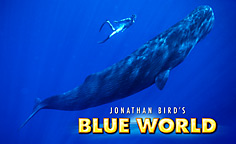
|
PLEASE DONATE! |
© Jonathan Bird/ORG The phylum Cnidaria (pronounced nid-AIR-ee-ah) contains approximately 9000 living species worldwide. They are among the simplest of the so-called "higher" organisms, but are also among the most beautiful. The creatures in this phylum are radially symmetrical. This means that the parts of the body extend outward from the center like the spokes on a bicycle wheel. A common example of radial symmetry is the sea star (a member of the Echinoderm phylum) or the anemone, a Cnidarian (seen below). The Cnidarians include the hydroids, jellyfish, anemones, and corals. All Cnidarians have tentacles with stinging cells in their tips which are used to capture and subdue prey. In fact, the phylum name "Cnidarian" literally means "stinging creature." The stinging cells are called cnidocytes and contain a structure called a nematocyst. The nematocyst is a coiled thread-like stinger. When the nematocyst is called upon to fire, the thread is uncoiled, and springs straight. The harpoon-like thread punctures through the cnidocyte wall and into the prey. Most Cnidarians also have a toxin in their stinger which helps to disable the prey. The nematocyst is fired either by the tentacle touching something, or in some cases by a nerve impulse from the animal telling it to fire. Most Cnidarian's nematocysts are not harmful to humans, as the stinger cannot penetrate sufficiently into human skin to inflict any harm. There are some jellyfish, however, which can deliver extremely painful, and in a few cases, even fatal, stings to humans. The Cnidarian can have one of two basic body types, polypoid or medusoid. The polypoid (POL-ip-oyd) is the configuration of corals and anemones, with the tentacles and mouth generally facing up, and the other side affixed to a substrate or connected to a colony of other creatures of the same species. In the Medusoid, the organism is essentially upside-down, with the mouth and tentacles generally pointed down. These types of Cnidarians are usually free-swimmers, like jellyfish. This is why the anemone is sometimes called an upside-down jellyfish; that's just about what it is! The Phylum is divided up into 3 Classes, called the Hydrozoans (meaning "water-animals"), the Anthozoans (meaning "Flower-animals") and Scyphozoans (meaning "bowl-animals"). HYDROZOANS SCYPHOZOANS Watch the new free internet TV series about the underwater world:  JONATHAN BIRD'S BLUE WORLD
|
The two different forms of a Cnidarian body. A coral colony consists of hundreds or thousands of tiny polyps. Each polyp is an individual animal (basically a small anemone) but they live together as a group. The Lion's Mane Jelly is a venomous Scyphozoan which can sting people with its long tentacles. Since the tentacles can hang so far down, the jelly can use these tentacles to kill fish which swim through them without ever seeing the jelly itself way up above! This is an example of a cnidarian with a medusoid shape.
|
All images on these pages for non-profit educational use only.
update 3/5/2021






